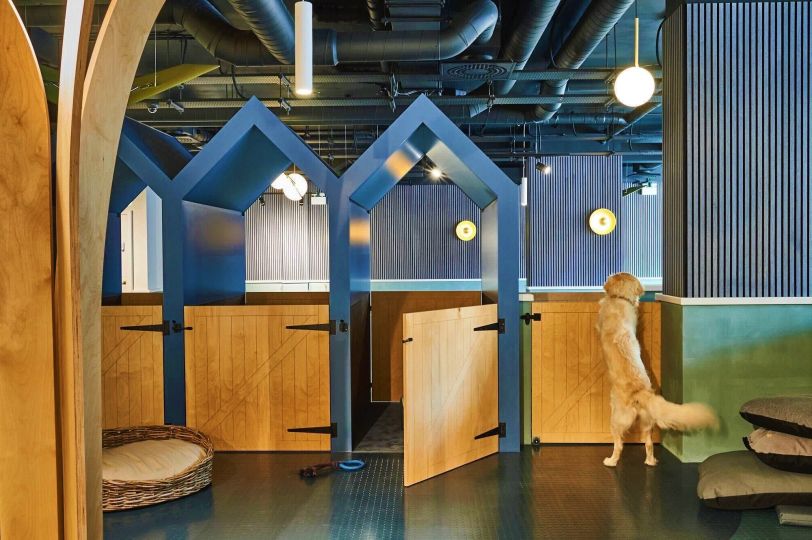
In Conversation With: WagWorks

Moving house can be a big moment for any family - and that includes the four-legged members too. To find out about all the tips and tricks, we’ve teamed up with WagWorks - a membership club for dogs - to help make the transition as smooth as possible.
How does moving house typically affect a dog’s wellbeing or behaviour?
Moving house can be a stressful experience for both humans and dogs, but as our in-house behaviourist Winkie Spiers often says, it's how you manage the transition that makes all the difference. Dogs are highly sensitive to change and pick up on our emotions - so when routines shift and stress levels rise, they often mirror that anxiety.
However, Winkie also highlights a valuable silver lining: moving home is an ideal opportunity to establish ‘new habits in a new space.’ If your dog had behavioural issues in your previous home – such as barking at the front door - you can take this chance to introduce new, calmer routines from day one in the new house. Dogs don’t hold onto associations with spaces the way we do, which means a fresh start really can mean just that.
What advice would you give to pet owners ahead of a big move?
We recommend involving your dog in the moving process as early as possible. If you can, take them to visit the new home before moving day so they can start to adjust to the new sights and smells gradually.
In the lead-up to the move, offer extra calm enrichment at home, such as food-stuffed puzzles or natural chews. These activities help dogs self-regulate and reduce stress, making them better equipped to cope with the changes ahead.
By integrating your dog into the process and supporting them with simple, calming routines, you can help make the transition smoother for everyone.

Do certain dog breeds adapt more easily to change than others?
While some breeds may appear more laid-back than others, it’s not so much about the breed as it is about the individual dog’s physical and emotional health. Dogs already dealing with stress, anxiety, or health issues are likely to find a move more challenging, regardless of breed.
The first impression of the new home really matters. Bringing familiar scents, bedding, and toys from the old house helps provide comfort. And offering plenty of chews and treats can encourage calm and positive associations. Ultimately, it’s about supporting your dog as an individual through a period of big change.
Are there any signs a dog might show they’re struggling post-move, and how can you help them?
Your dog may lose interest in food, become unusually vocal (barking or whining), or seem restless and unable to settle. In some cases, dogs may regress in house training or become more attached to you, following you from room to room and showing signs of separation anxiety. That’s why it’s so important to support your dog through this transitional stage with patience, consistency, and comfort. Always reach out to a professional if your dog is struggling - they can help put a plan in place to ease your dog’s anxiety and get them back to feeling their usual self.
What should pet owners look for in a new neighbourhood to ensure their dog’s happiness?
Dogs feel more at ease in areas where there are other dogs around - just picking up familiar scents can help them settle more quickly. A neighbourhood with plenty of dogs, friendly walking routes, and access to parks makes for a more enriching daily routine.
It’s also worth checking for a good local vet nearby, and of course, being close to a WagWorks! We can offer support in many different ways, whether that’s through an enriching day at daycare or a 101 consultation with our training team. 
Have you ever helped prepare a dog for moving day? What does that look like?
Preparing a dog for moving day is all about keeping things as familiar and predictable as possible. Try to stick to your dog’s normal routine, whether that’s their usual drop-off time at WagWorks or their regular walk with familiar dog friends. Dogs rely on daily patterns as cues to understand what’s happening around them, so maintaining that rhythm helps reduce anxiety.
When packing up, allow your dog to stay near you rather than shutting them away. Dogs are naturally curious and often feel more secure when they can observe what’s going on - being involved helps them process the changes.
Once you arrive at the new home, introduce your dog to the space slowly and calmly. Walking them through the house on a lead and allowing them to sniff each room helps build confidence. Dogs have between 125 to 300 million scent receptors and rely heavily on smell to make sense of their environment, so taking the time to let them explore at their own pace gives them a reassuring start to life in their new surroundings.
How long does it usually take for dogs to settle into a new home?
It really depends on the individual dog - their personality, age, and life experiences all play a role. Some dogs adapt almost immediately, while others may take a few weeks to fully settle.
Establishing a familiar routine from day one helps provide a sense of stability. Bringing over habits from the old house - like walk times or feeding schedules - gives your dog comforting reference points. Calm reassurance from you is also essential.
WagWorks’ clubs are designed entirely around dogs’ needs, offering daycare, grooming, healthcare, and training - all under one roof. With an expert team and a holistic approach, they aim to support both dogs and their owners through every stage of life together - including those big milestones like moving home. WagWorks is currently based in Fulham, with a second club opening in late 2025 in Islington.
